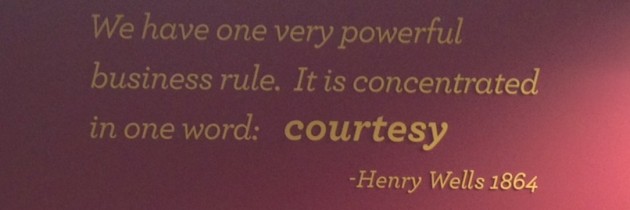When Values and Marketing Are Not Aligned
 I like Wells Fargo. I bank with them, and most of my encounters with their staff have been very positive. But after assessing their values – as part of my research on Fortune 500 companies – I couldn’t help wonder if something was misaligned.
I like Wells Fargo. I bank with them, and most of my encounters with their staff have been very positive. But after assessing their values – as part of my research on Fortune 500 companies – I couldn’t help wonder if something was misaligned.
As stated on their website, and in their extremely detailed 44-page Vision and Values brochure, Wells Fargo has five values:
- People as a competitive advantage
- Ethics
- What’s right for customers
- Diversity and inclusion
- Leadership
In all my research, not many companies could compete with Wells Fargo on the volume of content associated with their values. Pound for pound, this document is huge. It would take a forest to make enough paper to produce their Vision and Values brochure for every employee (which makes me wonder how many know it…).
Now, there’s nothing wrong with the values of Wells Fargo, even though all five are part of the 17 Common Values expected from every business. There is just nothing unique here.
Then I discovered the real disconnect.
I recently visited a Wells Fargo branch outside of Raleigh, North Carolina and saw a large sign behind the counter that read:
We have one very powerful business rule. It is concentrated in one word: courtesy – Henry Wells 1864
Courtesy is a unique and powerful value that was clearly part of the foundation when Henry Wells and William Fargo found the bank over 150 years ago.
So why wouldn’t Wells Fargo include Courtesy as one of their core values today?
A Common Corporate Disconnect
Based on my experience working with companies of various sizes, I can easily imagine what’s happened.
- The Values Exercise. At some point in the company’s recent history, the Corporate Governance committee, or the Corporate Communications department, or the Human Resources department, or quite possibly the CEO’s office, conducted a strategic planning exercise with the intent of identifying the company’s core values. The end result of a very lengthy and time-consuming process was the output of the 44-page Vision and Values brochure. I’m sure the team was very proud of this document.
- The Brand Promise. At some point in the past 10-15 years, the company’s marketing department, or public relations department, or quite possibly the bank’s branch designer, discovered this old quote from Henry Wells and decided to post a copy inside every branch for all customers (and employees) to see. I’m sure the marketing folks thought it made perfect sense. And of course, now it is just part of the décor.
The net result is the public display of a simple, yet powerful brand promise that has NO reference or link to the comprehensive, convoluted corporate Vision and Values document.
Here’s the irony.
I suspect all employees are expected to read and understand the lengthy values document, with the additional likelihood that everyone is asked to provide their signature indicating they have read it. I also suspect few can remember much about these values (if at all) due to the volume of information associated with them.
Yet, if asked for the one quality or value expected from every employee, I suspect most employees would say courtesy – because they see it every day. It’s simple to remember, and it seems relevant to the business. It just makes sense.
Strangely, this is a case where it is possible for the brand experience to equal the brand promise (increasing brand equity). But unfortunately the stated values have no place in this equation.
If only they could align what the employees already know with the stated values. It would make employee training so much simpler.
Now, I know that some might argue that Courtesy is woven into Wells Fargo’s existing five values. But if it’s that important, why not make it one of the bank’s values?









